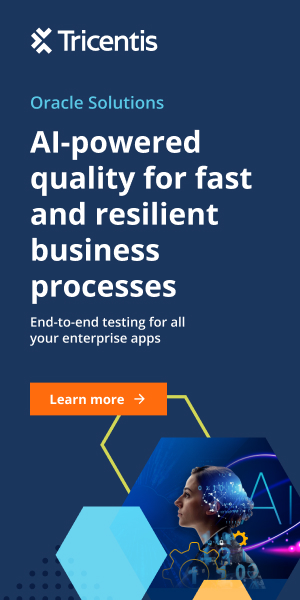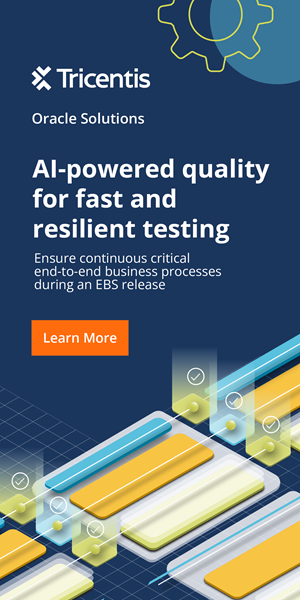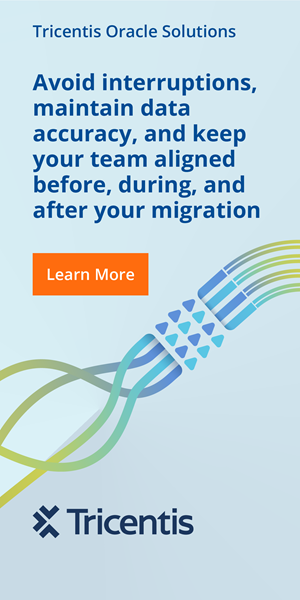Oracle Applications, whether ERP Cloud, E-Business Suite, or a complex hybrid landscape, handle many critical processes for organizations. Still, managing Oracle’s quarterly updates, customizations, integrations, and looming cloud migrations can overwhelm organizations, as a single misstep can trigger downstream failures, bringing business to a halt.
Although manual testing has been a traditional safety net, it is often a slow, cumbersome process. It is a resource drain, prone to human error, and struggles to cover the vast web of modern enterprise systems. Early automation helps, but it often requires technical wizards and breaks easily with UI changes. So, how can an organization release new versions faster while reducing risk in this high-stakes environment? The answer lies in AI-powered test automation.
Untangling the interconnected ERP Web
Take the example of a simple ‘order-to-cash’ process. It might start in Oracle but likely touches dozens of other applications via APIs and microservices. A seemingly minor update in one corner can have unexpected, business-critical consequences elsewhere. Add a cloud migration project into the mix, and the complexity and risk soar. Users must validate that every workflow, every integration, and every customization holds up before going live. This is where traditional testing often falls short, as it struggles to provide the speed and comprehensive coverage needed.
AI is fundamentally shifting how organizations approach quality assurance. Testing solutions by Tricentis leverage AI to turn testing from a bottleneck into an accelerator for Oracle customers. Here’s how:
- Vision AI and self-healing: Tricentis Test Automation tools with Vision AI act like a human eye, identifying UI elements based on visual cues, not just underlying code, making tests more resilient. Additionally, when Oracle updates roll out and UIs change, AI steps into self-heal test scripts, identifying the changes and adapting the tests automatically, slashing maintenance time.
- Risk-based testing: Not all business processes carry the same weight. AI can analyze an organization’s Oracle landscape, identify the most critical and high-risk workflows, and help prioritize testing efforts. Organizations can focus their resources on ensuring critical functions are enduring without wasting cycles on low-impact areas. This means faster feedback loops and smarter go/no-go decisions.
- Generative AI and codeless automation: With tools like Tricentis Tosca Copilot, organizations can leverage generative AI to create test cases from requirements or simple natural language prompts. This, combined with Tricentis Test Automation’s model-based, codeless approach, means business analysts and Oracle functional experts can actively participate in building end-to-end automation without needing a deep coding background. It bridges the gap between business and IT, accelerating test creation.
- End-to-end and data integrity: Tricentis’ solutions are designed to test across the entire business process, covering over 160 technologies. For Oracle migrations and regular operations, its data integrity tools use AI to validate vast datasets, ensuring data moves accurately between systems and preventing costly errors and compliance headaches.
Speed with Confidence
By infusing testing with AI, Tricentis helps Oracle customers overcome the speed versus risk dilemma. Teams can achieve automation rates exceeding 90%, accelerate release cycles significantly, and reduce costs. They can also confidently deploy Oracle updates and innovations, knowing that AI has helped them intelligently assess risk, build resilient tests, and validate processes from end to end.
Learn more about Tricentis’ testing solutions for Oracle with the Tricentis AI-powered platform at Ascend 2025 from June 8-10 in Orlando, Florida.
What this means for ERP insiders
De-risk your cloud journey: Tricentis provides a crucial safety net for organizations migrating to Oracle Cloud. They can use its AI-powered, end-to-end testing to validate complex workflows before, during, and after migration. Its data integrity tools ensure critical business data arrives intact, a common pitfall in large-scale ERP transformations. This prevents go-live disasters and builds confidence in a new cloud environment.
Stop dreading Oracle Cloud’s mandatory updates: Tricentis use cases show how AI-driven self-healing dramatically reduces test script maintenance. Coupled with risk-based testing, organizations can focus validation efforts on changes that pose the highest risk to their specific configurations and integrations, making update cycles faster and less disruptive.
Go codeless to empower your process experts: Tricentis’s codeless, model-based approach, boosted by AI such as Vision AI and Tosca Copilot, allows functional analysts and business users to build and maintain powerful test automation. This ensures that an organization’s tests reflect actual business use, leading to higher quality and faster user acceptance.
















